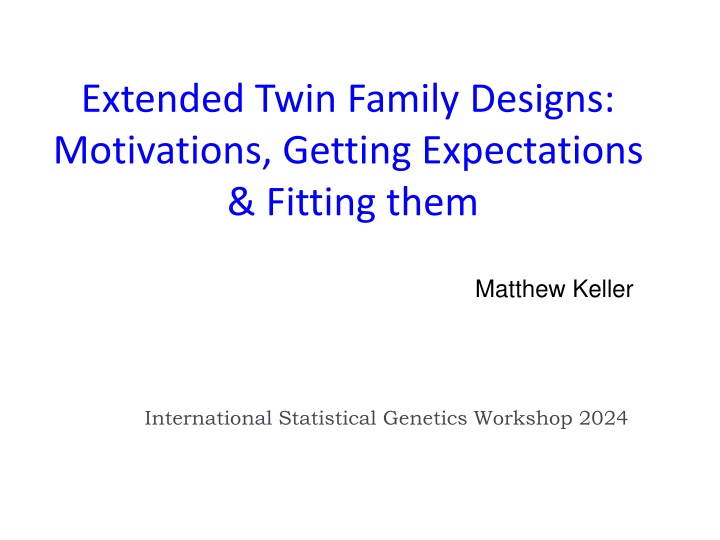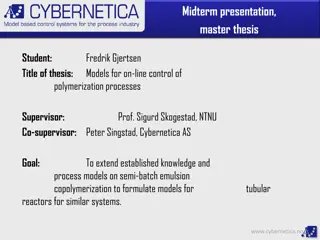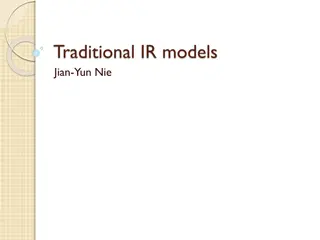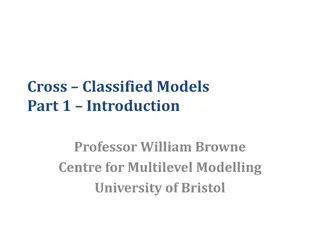
Understanding Extended Twin Family Designs: Motivations and Expectations
Dive into the world of extended twin family designs, exploring motivations, expectations, and fitting them in statistical genetics workshops. Discover how modeling assortative mating and passive genetic-environment covariance impacts the classical twin design and more.
Download Presentation

Please find below an Image/Link to download the presentation.
The content on the website is provided AS IS for your information and personal use only. It may not be sold, licensed, or shared on other websites without obtaining consent from the author. If you encounter any issues during the download, it is possible that the publisher has removed the file from their server.
You are allowed to download the files provided on this website for personal or commercial use, subject to the condition that they are used lawfully. All files are the property of their respective owners.
The content on the website is provided AS IS for your information and personal use only. It may not be sold, licensed, or shared on other websites without obtaining consent from the author.
E N D
Presentation Transcript
Extended Twin Family Designs: Motivations, Getting Expectations & Fitting them Matthew Keller International Statistical Genetics Workshop 2024
Points of this lecture Extending the Classical Twin Design (CTD) to include additional relative types not only allows estimation of additional quantities, but it also probably produces less biased estimates Modeling assortative mating and passive G-E covariance in SEM require different rules and non- linear constraints Getting proper variance/cov expectations How to fit ETFDs in OpenMx
Classical Twin Design (CTD) Assumption biased up biased down Either ??or ?? is zero ?? No assortative mating ?? No A-C covariance ?? ?? & ?? ??& ?? ?? & ?? 1 A A 1/.25 C C E E a a c c e e D D d d PT2 PT1
Assortative mating consequence on ?? AM: phenotypic correlation between mating partners Many examples (e.g., height ~.25; IQ ~ .4; Attitudes ~ .6) If AM leads to genetic similarity in partners (as it does if it s primary phenotypic AM), there are genetic consequences: Height ??increases in the population because tall ( short ) alleles are more concentrated in individuals than expected. It only increases between-family VA, not the within-family VA (segregation variance). E.g., a tall allele sitting in an egg waiting to see what other height alleles you ll get paired with from a sperm swimming to you, they are more likely than chance to be other tall alleles (both at the same locus and at others; & this just considers the effects on ?? in 1st gen)
AM consequence on relative covariance AM increases genetic covariances and correlations between relatives (e.g., sibs, parents, cousins, etc). E.g.: ??,??=1 2(1 + ? ????? 2 ) Consider again being a tall allele in a zygote. You are watching your co-twin s zygote get formed. Regardless of whether you exist (are IBD) in your co-twin s zygote, you can expect more tall alleles in your co-twin s zygote. Thus, you can also expect to share more tall alleles with your sibling(s) than expected under random mating. AM biases ?? upwards and ?? (or ??) downwards ???.?1,?2is already 1 so AM cannot increase it AM will increase ???.?1,?2> .50
Intuition behind segregation variance = VA and variance of average additive genetic effect = VA (absent AM) Typical parameterization (DZ twins or sibs) VA VA VA E A A E Tw2 Tw1 Equivalent parameterization VA VA A VA E E A2 A1 Tw1 Tw2
Intuition behind segregation variance = VA and variance of average additive genetic effect = VA (absent AM) Equivalent parameterization Between family VA Average additive genetic effect in this family VA Segregation var Segregation var VA A VA E E A2 A1 Tw1 Tw2 Unique additive genetic effects
In context of AM, segregation variance still = VA whereas variance of average additive genetic effect > VA VA + ?? due to AM VA A VA E E A2 A1 Tw1 Tw2
Passive G-E Covariance (aka genetic nurture) Covariance between the average genetic effect in a family and the familial environment that occurs when parental trait directly influences the offspring trait, leading to covariance between genes affecting a trait and the offspring rearing environment E.g., educated parents pass on both genes and environments that predispose to higher education Because it is a covariance between the average genetic effect and the familial environment, it increases the covariance of all siblings by the same amount regardless of their relatedness (e.g., MZ vs. DZ). It therefore mimics, and leads to an overestimate, of ?? in the CTD.
NTFDs get us around these assumptions Assumption biased up biased down Either ??or ?? is zero No assortative mating No A-C covariance We don t have to make these q q w w A A x x C C E E a a c c e e D D d d PFa PMa m m Nuclear Twin Family Design m m A A 1/.25 C C E E a a c c e e D D d d PT2 PT1
We can model ?? as either ?? or ?? With parents, we can break ?? up into: S = env. factors shared only between sibs S C F = familial env factors passed from parents to offspring F But we can only estimate one of these (or more technically, three of ??, ??, ??, & ??) 1 1 A A A A F F 1/.25 1/.25 C C S S E E E E a a f a a f c c e s s e e D D e D D d d d d PT2 PT1 PT 2 PT 1
Nuclear Twin Family Design (NTFD) w w q q A A F F x x S S E E f f a a s s e e D D d d PFa PMa m m m m Note: m estimated and f fixed to 1 zs A A F F zd S S E E f a a f s s e e D D d d PT2 PT1
On average across 38 traits CTD vs. ETFD results* ?? 65% higher in CTD ?? 43% lower in CTD ?? 45% lower in CTD when r(spouse)~0 ?? 100% higher in CTD when r(spouse)>0 ?? 18% higher in CTD ETFDs have lower precision but also less bias than CTDs. Overall, they are much more accurate than CTD results. Accuracy across all sims: CTD=.14; NTF=.07; ETFD=.045 o * Coventry & Keller, 2005
Nuclear Twin Family Design (NTFD) w w q q A A F F x x S S E E f f a a s s e e D D d d PFa PMa m m m m Note: m estimated and f fixed to 1 zs A A F F zd S S E E f a a f s s e e D D d d PT2 PT1 Assumptions: Only can estimate 3 of 4: ??, ??, ??, ?? (bias is variable) AM due to primary phenotypic assortment (bias is variable)
Path Diagrams Path diagrams pictorially represent causal models. They aid in deriving the variances and covariances implied by the model. Observed Variables Latent Variables Causal Paths (Co)variance Paths
Deriving variances & covariances 1. Identify all legitimate chains (a series of paths) that connect one variable to another (covariances) or connect a variable back to itself (variances) 2. The expected value of a chain is the product of all coefficients associated with each path making up that chain 3. The final expected variance or covariance equals the sum of the values of all legitimate chains
Path Tracing Rules. Legitimate chains: All chains begin by travelling backwards against the direction of a (single or double-headed) arrow, head to tail. 1.
Path Tracing Rules. Legitimate chains: All chains begin by travelling backwards against the direction of a (single or double-headed) arrow, head to tail. Once a double headed arrow has been traversed, the direction reverses such that the chain travels forward. 1. 2.
Path Tracing Rules. Legitimate chains: All chains begin by travelling backwards against the direction of a (single or double-headed) arrow, head to tail. Once a double headed arrow has been traversed, the direction reverses such that the chain travels forward. All chains must include exactly one double-headed arrow. This implies a chain must change directions exactly once. 1. 2. 3.
Path Tracing Rules. Legitimate chains: All chains begin by travelling backwards against the direction of a (single or double-headed) arrow, head to tail. Once a double headed arrow has been traversed, the direction reverses such that the chain travels forward. All chains must include exactly one double-headed arrow. This implies a chain must change directions exactly once. All chains must be counted exactly once and each must be unique. Note: order matters: abc is a distinct chain from cba. 1. 2. 3. 4.
Path Tracing Example W x q F A a f 1 e E P p 1 z Z Y CV(Y,F) = V(P) = V(Y) =
Path Tracing Rules. Legitimate chains: All chains begin by travelling backwards against the direction of a (single or double-headed) arrow, head to tail. Once a double headed arrow has been traversed, the direction reverses such that the chain travels forward. All chains must include exactly one double-headed arrow. This implies a chain must change directions exactly once. All chains must be counted exactly once and each must be unique. Note: order matters: abc is a distinct chain from cba. Copaths are special. They model ordering bw individuals in a way that doesn t imply a common cause of the covariance. They may only be traversed once per chain, but once crossed, rule 3 resets. A chain therefore must contain a double-headed arrow before traversing a copath and one after traversing a copath. 1. 2. 3. 4. 5. PFa PMo
Special considerations in ETFDs Typically, we assume that AM and VT have reached equilibrium - i.e., the levels of AM and VT have been stable across multiple generations This allows us to set the variances of A & F and the covariances between A & F in the parental generation to be equal to those in the offspring generation This results in non-linear constraints: parameters are functions of those same parameters Solving these requires iterative procedures, e.g., ML. Closed-form solutions of these estimates are typically not possible.
Nuclear Twin Family Design (NTFD) w w q q A A F F x x S S E E f f a a s s e e D D d d PFa PMa m m m m zs A A F F zd S S E E f a a f s s e e D D d d PT2 PT1 V(P) =
Nuclear Twin Family Design (NTFD) w w q q A A F F x x S S E E f f a a s s e e D D d d PFa PMa m m m m zs A A F F zd S S E E f a a f s s e e D D d d PT2 PT1 q =
Nuclear Twin Family Design (NTFD) w w q q A A F F x x S S E E f f a a s s e e D D d d PFa PMa m m m m zs A A F F zd S S E E f a a f s s e e D D d d PT2 PT1 x =
Nuclear Twin Family Design (NTFD) w w q q A A F F x x S S E E f f a a s s e e D D d d PFa PMa m m m m zs A A F F zd S S E E f a a f s s e e D D d d PT2 PT1 w =
Nuclear Twin Family Design (NTFD) w w q q A A F F x x S S E E f f a a s s e e D D d d PFa PMa m m m m zs A A F F zd S S E E f a a f s s e e D D d d PT2 PT1 CV(DZ) =
Fitting NTFDs in OpenMx Figure out expectations by assuming equilibrium and setting the parental parameter = the offspring (all ways to get variance or cov in offspring) Define the parental parameter as a free parameter in mxMatrix to be estimated Define the offspring parameter as an mxAlgebra with the math in it Set these two parameters to be equal using mxConstraint Figure out the relative covariances and means, and define these using mxAlgebra for each group (MZ & DZ families) Put these relative covariances into a 4x4 var/covar matrix using mxAlgebra for each group Define the data you are using with mxData Put the var/covar expectations and mean expectations into mxExpectationNormal Put all these together in mxModels for each group Put these in an mxFitFunctionMultigroup and put that into an overall mxModel Run the model using mxRun and look at summary() of your model to get estimates
NTFD script & material In /faculty/matt/ETFD.2024: NTFD.Example.R script that sets S=0 and fits VF in a simulated dataset. If there is time, try running it and interpreting output. GeneEvolve.Dataset3.pdf has the true parameters from GeneEvolve simulation: VA = .49 VD = .10 VF = .21 VE = .39 COV(A,F) = .20 r(spouse) = .30 Keller_Cascade_2009.pdf goes over all this math
Conclusions All models require assumptions. More assumptions = more biased estimates on average. ETFDs typically provide less biased parameters and more insights Simple path tracing rules make it possible to derive expectations in ETFDs when there is VT and AM. This would lead to otherwise intractable math arising from recursive relationships caused by AM and VT. But ETFDs have drawbacks. More complicated & mistake prone. Lower precision. Need larger datasets. Multivariate ETFDs also exist! Talk to Hermine, Jared, or Xuanyu Also possible to model different types of AM and VT
Further reading on this lecture Cloninger CR, Rice J, Reich T (1979). Multi-factorial inheritance with cultural transmission and assortative mating II: A general model of combined polygenic and cultural inheritance. American Journal of Human Genetics, 31, 176-198. Eaves LJ, Last KA, Young PA, Martin NG (1978) Model-fitting approaches to the analysis of human behaviour. Heredity 41:249-320 Fulker DW (1982) Extensions of the classical twin method. Human Genetics. Part A: The Unfolding Genome (Progress in Clinical and Biological Research Vol 103A). p. 395- 406 Fulker DW (1988) Genetic and cultural transmission in human behavior. Proceedings of the Second International conference on Quantitative Genetics Eaves LJ, Heath AC, Martin NG, Neale MC, Meyer JM, Silberg JL, Corey LA, Truett K, Walter E (1999) Comparing the biological and cultural inheritance of stature and conservatism in the kinships of monozygotic and dizygotic twins. In: Cloninger CR (Ed) Proceedings of 1994 APPA Conference. p. 269-308 Keller MC, Medland SE, Duncan LE, Hatemi PK, Neale MC, Maes HHM, Eaves LJ. Modeling extended twin family data I: Description of the Cascade Model. Twin Research and Human Genetics, 29, 8-18. Keller MC, Medland SE, & Duncan LE (2010). Are extended twin family designs worth the trouble? A comparison of the bias, precision, and accuracy of parameters estimated in four twin family models. Behavior Genetics. Maes HHM, Neale MC, Martin NG, Heath AC, & Eaves LJ (1999). Religious attendance and frequency of alcohol use: Same genes or same environments. A bivariate extended twin kinship model. Twin Research and Human Genetics, 2, 169-179.





















